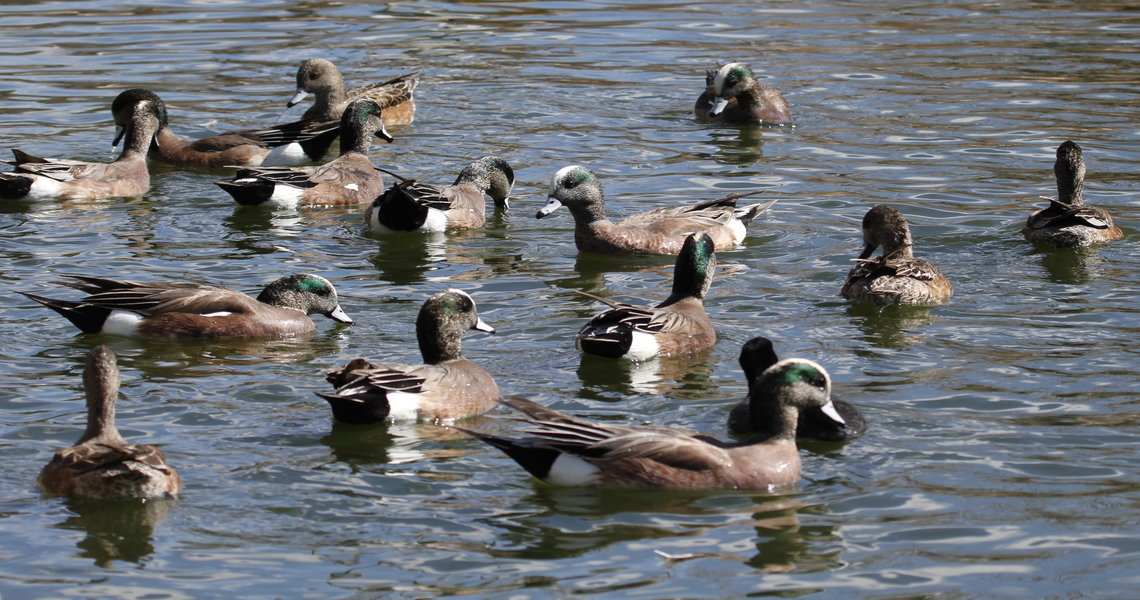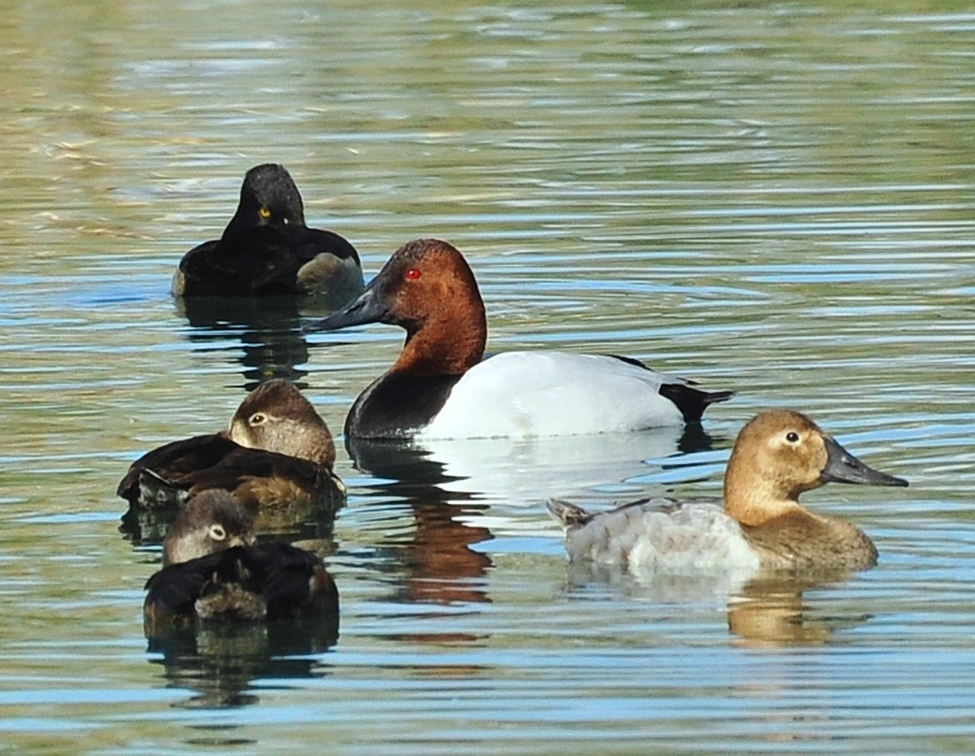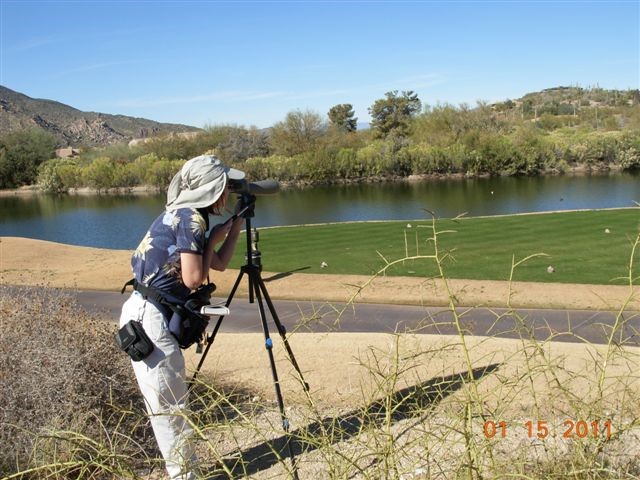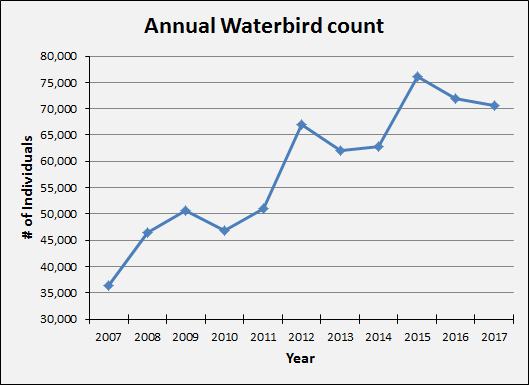
American Wigeon have become the most abundant species counted on surveys (photo courtesy of Emily Clark).
By Chrissy Kondrat-Smith, Permits Biologist and Troy Corman, Avian Monitoring Coordinator, Arizona Game and Fish Department
Numerous survey methodologies help us collect data to better understand the often-fluctuating status of bird populations, and assist in the decision process for best management practices. With diverse habitats, unique regional and changing climates, and the broad range of complex breeding seasons of various bird populations in Arizona, it’s not always possible to capture population trends in one annual or seasonal blanket survey, such as the national Breeding Bird Survey (BBS) or Christmas Bird Count (CBC). This triggered the need to establish a program to monitor species not adequately monitored by the BBS or other large-scale surveys.

Numerous species of waterbirds spend the winter at the Tempe Town Lake (photo courtesy of Jeff Sterr).
To address this need, the Arizona Bird Conservation Initiative (ABCI), a voluntary partnership of people working to conserve, monitor, and enhance bird populations and their habitats with the goal of “keeping common birds common,” established the Arizona Coordinated Bird Monitoring program (AZCBM). The program has collaborated with numerous partners to design, implement, and maintain support for several projects targeting groups of species in need of monitoring in Arizona. Annually, the program implements a suite of multi-species monitoring projects that address birds and priority habitats. These include species that breed in marsh, riparian, grassland and desert habitats; wintering waterbird populations; colonial nesting species; and nocturnal species. One such example is a volunteer driven effort to monitor wintering waterbirds around Phoenix, dubbed the Greater Phoenix Area Waterbird Survey.

Volunteer surveyor, Stacy Burleigh, scans for waterbirds on an artificial lake at the Boulders Resort in Scottsdale (photo courtesy Cathy Madsen).
In the recent past, the greater Phoenix area has exhibited an average human population growth rate of nearly 13 percent per year. That pegs the Phoenix area, encompassing approximately 2,200 square miles across 26 incorporated and outlining towns, as the 10th fastest-growing metro area in the U.S. Corresponding to the human population growth, golf courses, ponds and other residential water features often accompany the growing desert communities. These artificial water bodies attract numerous species of waterbirds, prompting a need to monitor their populations for potential urban-wildlife conflicts and to document their status and trends.
Established in 2007, the Greater Phoenix Area Waterbird Survey aims to monitor the wintering populations of waterbirds across an urban landscape not covered by the Christmas Bird Count. The survey is conducted annually on a single day in mid-January, primarily by an amazingly dedicated team of over eighty skilled volunteers. They visit the numerous urban lakes, ponds, canals and marshes counting wild ducks, geese, coots, grebes, cormorants, herons, egrets and other water-foraging bird species wintering at these created water bodies.

The number of individuals detected on the Greater Phoenix Area Waterbird Survey has increased dramatically since surveys began in 2017 (Graph by Arizona Game and Fish Department).
Even after the first few annual surveys, we realized that in comparable size, there is no other location in Arizona attracting as high of diversity and density of wintering aquatic birds as this highly urbanized area. The overall number of waterbirds counted has steadily increased during the past decade. Counts now average over 70,000 birds of 60+ species, with a high of 76,000 birds in 2015. The most abundant species counted annually (in decreasing order) include American Wigeon, American Coot, Mallard, Canada Goose, and Northern Shoveler. These species regularly account for over 60% of all birds counted. Some species have shown notable variability from one winter to the next, while others have indicated a steady increase (or decrease).
The most abundant species, American Wigeon, have increased to over 24,000 individuals. Canada Geese, another species of interest, have averaged over 4,500 in recent years. Neotropic Cormorant totals increased to a high of greater than 3,500 individuals in 2017, while Double-crested Cormorant average far fewer, with possible declines noted. Data is being used to help evaluate concerns of increasing cormorant numbers on stocked urban fish, identify important concentration areas, and to establish research needs on potential nuisance species (such as turf damaging hordes of grazing American Coots, American Wigeon and Canada Geese).
These and other projects are continuing to provide critical information that contributes to decision making on how to conserve, manage, monitor and enhance the diverse breeding and wintering bird populations and their habitats in Arizona. Learn more about the Greater Phoenix Area Waterbird Survey here. Are you interested in participating in next year’s count? Email Troy Corman.


 English
English  Español
Español